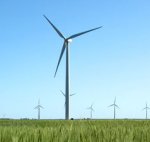GE has been conducting research into new low-noise wind turbine blade design. It’s not about addressing infrasound – which has already been shown not to be an issue in areas surrounding wind farms – it’s all about producing more power.
“There’s no question, aerodynamic noise is a key constraint in wind turbine blade design today”, says Mark Jonkhof, Wind Technology Platform Leader at GE Global Research.
“By using high-performance computing (HPC) to advance current engineering models that are used to predict blade noise, we can build quieter rotors with greater blade tip velocity that produce more power. This not only means lower energy costs for consumers, but also a significant reduction in greenhouse gas emissions.”
Aerodynamic noise refers to the “swooshing” sound created as the leading edge of a turbine blade moves through the air. GE predicts that a mere one decibel drop in this sound would lead to an annual two percent increase in power per turbine. With an estimated 240 gigawatts of wind power to come online globally over the next five years, GE says this would be the equivalent of 5 gigawatts of added wind energy capacity.
The company currently uses wind tunnel technology to test the noise levels of its wind turbines, as well as on-site acoustic tests at wind farms; but new computer modelling has advanced these techniques.
The GE team partnered with Sandia National Laboratories in New Mexico, spending three months running high-fidelity Large Eddy Simulations (LES) on a single wind blade section with the lab’s Red Mesa supercomputer. The LES system and resulting analysis provided fresh insight about airflow over wind turbines and will play a key role in building the next generation of quiet turbine blades.
“Having access to Sandia’s supercomputer was invaluable in our ability to conduct these experiments and make discoveries that will bolster wind power’s potential. Access and availability to HPC resources offers a critical advantage to companies trying to compete in a global environment.”
Related:
Wind Farm Infrasound Myth Debunked
Wind Turbine Syndrome – A Communicated Disease?












































